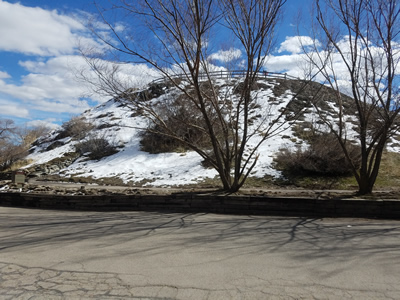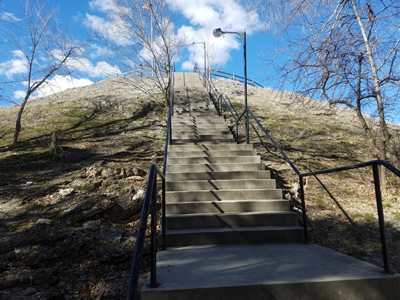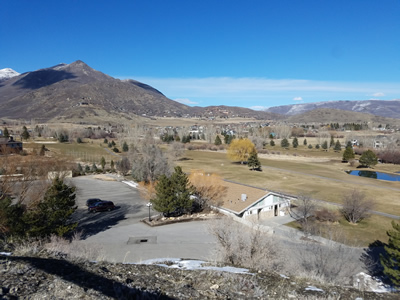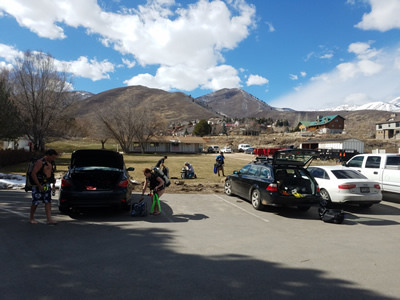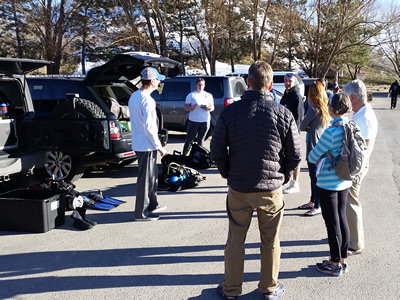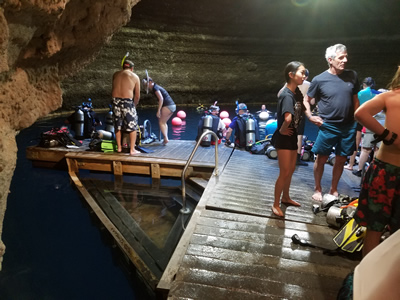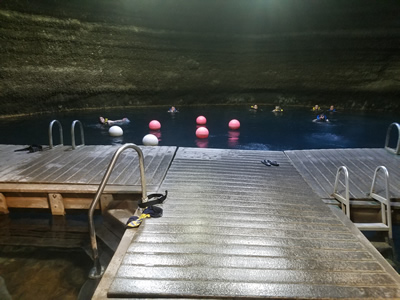PADI Dive Certification
Sandy and I used to scuba dive quite a bit. We both got certified back in the mid nineties. Back then we usually went on two or three tropical vacations a year and we did a lot of diving on those trips. As our kids got older, all of them got certified as well. In 2003 we did a dive trip to Grand Cayman with all of the kids to celebrate Tim's high school graduation. We went to Bonaire in 2006 with Mickey and Shannon to go diving.
That turned out to be the last time that we went diving. There were several reasons why we stopped. Sandy had a lot of trouble with her mask leaking on our last trip. She got frustrated and lost interest in diving. In 2007 we moved to Singapore. When you live on the equator, a tropical vacation doesn't seem so enticing. And even though the water is warm, there isn't any good diving near Singapore. There are no reefs and the visibility is terrible. The kids grew up and went off on their own so I couldn't go diving with them anymore. I tried a few times to get Tim or Mickey to go on a dive trip, but they had jobs and families and couldn't get away. Since diving requires a buddy, I couldn't dive by myself. Sandy and I started to think of ourselves as retired divers.
That's finally going to change. When my mother died last summer, I inherited some money from my parents and I wanted to share some of that with the grandkids. Of course I could just give them some money. That's always welcome but I'm sure that in six months everyone would be in exactly the same place that they are now with respect to expenses and bills. I wanted it to be something special so I came up with the idea of having a family reunion at a fun, exotic location. Our family is not very good at getting together. It's probably been ten years since Tim, Mickey and Shannon have all been together with us. I decided to use the inheritance money to pay for a tropical vacation for everyone. Of course I picked Bonaire, a place we have all been to and would probably agree was our favorite dive destination. Since we used to do dive trips together, this would give us a chance not just to have a reunion, but to do something fun that we used to enjoy doing together.
Scuba diving isn't really a dangerous activity but it is serious. That's why dive shops around the world require you to pass a certification course before they will let you dive. You need to learn safe practices which prevent accidents from occuring and the correct procedures for dealing with an emergency. Although certification lasts for life, after twelve years my knowledge and skills were pretty rusty. Most dive shops offer a refresher session, targeted specifically for people like me who were certified but have not been diving for some time. But I like to be methodical. Instead of just a quick review, I wanted to go through the whole certification process to make sure that I didn't miss anything. There are two main certification agencies in the US, NAUI (National Association of Underwater Instructors) and PADI (Profesional Association of Dive Instructors). Since I had certified with NAUI many years ago, I decided to do a PADI certification. I figured that since I was already certified, it would be quick and easy. It didn't exactly turn out that way.
There are three parts to certification. The first is academic. It's book learning where you study the effects of depth and pressure, equipment, and proper procedures for normal diving and handling emergencies. The second part is a series of five contained water dives (i.e. dives in a pool). Under controlled conditions you learn, practice and then have to demonstrate proficiency in a number of skills required for safe scuba diving, such as establishing neutral buoyancy, clearing your mask underwater if it becomes flooded, or helping your buddy with an out of air emergency. By practicing these skills in a pool you can easily recover if you do it incorrectly. By the time you are finished, you should be confident that you can do them on actual dives. That's the third part. You have to make four open water dives and demonstrate key scuba skills in real diving situations.
I started the process about a month before the trip. I signed up for an online course with PADI. I thought I would do it over the weekend, take the test, and then spend a week doing the confined water dives. I had forgotten just how much there is in the academic portion. It took me a week and a half of hard studying to finish. I probably spent more time than I needed to but I wanted to get 100% on the two exams (one is online and one is in the shop). Sadly I missed one question out of sixty on the online test. I did get all twenty questions right on the in person test. Close but no cigar but since I only needed seventy five percent, I definitely passed.
The pool sessions actually went well, although again I didn't realize how much I had forgotten. Instead of joining a regular class, which would meet once or twice a week, I signed up for private lessons at a local dive shop, Dive Magic. They have their own pool so I could progress at my own pace. My instructor's name was Jenny and she did a good job. I learned a lot and I was able to do all five confined water dives in three days and finish ahead of schedule.
At this point I originally planned to stop until the trip. When you live in a place like Boise and learn to dive in the winter, you can do what is known as a referral. You do the first two parts of the training at home, book learning and pool sessions. When you go on vacation in the tropics, you can finish your certification at a dive resort where you can do your open water dives under pleasant conditions, in warm water with good visibility. A lot of people do this. When we first certified, Sandy, Tim and Shannon all did referrals while Mickey and I didn't. It's a common practice and I figured that I would do it this time.
It turns out I had an alternative. Dive Magic was running a weekend trip to do open water certification dives for their regular classes. They go to a place near Midway, Utah called Homestead Crater. It's a limestone dome with a crater inside that is filled by a hot spring. Even during the winter the water is warm and since it's sixty five feet deep it counts as "real" diving. The crater trip was the very next weekend. Even though I hadn't trained with the class I was able to sign up.
The first two dives were Saturday evening at six so I didn't leave till that morning. The crater is on the grounds of the Homestead Resort, which is where I stayed. Besides the hot springs, there is a golf course and hiking nearby, although neither of those were options at this time of year. I had plenty of time when I got there so I had lunch at Cafe Galleria, the only real pizza place in the nearby small town of Midway.
I ran into one of the dive instructors in the lobby and he said to meet at 4:30 in the parking lot. We got our equipment ready and had our dive briefing there. The dome is actually very small inside so all the prep has to be done outside. Fortunately the weather was sunny and mild. I was assigned Mike as my buddy, another student who had done private lessons, and we had our own instructor, Gary.
The crater is busy in the winter so each dive group only gets a two hour slot. As the previous group filed out we went in. You walk through a tunnel cut through the rock to reach the crater. There were twenty students in our group and eight dive instructors. There isn't much room inside so even with our prep outside it was a total zoo as everyone got out of their warm clothes, got their gear on, and got into the water. It did live up to it's reputation for warm water though. The water temperature was ninety degrees. It was like diving in a hot tub.
Being underwater is always an amazing experience but this wasn't really a lot of fun. The visibility wasn't great - about twenty feet. There were just way too many people, both on the dock and in the water. Since there were so many students, most of whom weren't very skilled, you were constantly bumping into someone or someone was bumping into you. They had a frame made of PVC pipe hanging at fifteen feet so at least we could hang on to something while we did our skills. We did standard stuff like clearing our mask, doing regulator recovery and using our buddy's alternate air source. I was a little surprised that we did an emergency swimming ascent from fifteen feet. Seemed like it was just practicing getting a lung overexpansion injury. We were supposed to blow bubbles as we ascended and I did a good job - I had exhaled all my air by the time I was half way up. I still had my regulator though (it was a simulated emergency) so I wasn't worried and easily made it the rest of the way to the surface without having to take a breath.
I was pretty excited after the dives so I didn't fall asleep till well after midnight. That made it tough since our slot the next morning was at 6 am. To make it worse, we switched to daylight savings time overnight so I lost an extra hour of sleep. Even with that I was up earlier than I needed to be the next morning. I did my final two dives, we had our post dive meeting and then I was done. I had finished my PADI certification.
It was still early, so I showered, packed and checked out by 10 am. Since I was already in Utah and the weather was good, instead of driving home I headed south to the canyon country. I spent two days hiking which I'll cover in my next few posts.
